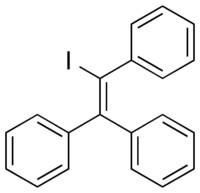Triphenyliodoethylene
Triphenyliodoethylene, also known as iodotriphenylethylene or as phenylstilbene iodide, as well as triphenylvinyl iodide, is a synthetic nonsteroidal estrogen of the triphenylethylene group that is related to triphenylchloroethylene and triphenylbromoethylene and was never marketed.[1][2][3]
 | |
| Clinical data | |
|---|---|
| Other names | Iodotriphenylethylene; Phenylstilbene iodide; Triphenylvinyl iodide |
| Drug class | Nonsteroidal estrogen |
| Identifiers | |
IUPAC name
| |
| PubChem CID | |
| Chemical and physical data | |
| Formula | C20H15I |
| Molar mass | 382.244 g/mol g·mol−1 |
| 3D model (JSmol) | |
SMILES
| |
InChI
| |
See also
References
- Proceedings of the XIth International Congress of Pure and Applied Chemistry: Chemistry in relation to medicine and theropeutics [sic], chemistry in relation to fuel, power and transport. Hepworth. 1947. p. 149.
In fact the cestrogenic activity of either triphenylbromoethylene or triphenyliodoethylene (J. 3d. Robson, A. Schonberg and H. A. Fahim)(3) (Table 1) compares with that of triphenylchloroethylene. A True Oestrogen and A Pro-oestrogen.
- Tom F. Burton (1952). British Abstracts. Bureau of Abstracts. p. 549.
Roughly quantitative data are reported for the antagonism between oestrogens (oestradiol, stilboestrol, doisynolic acid, allenolic acid, and triphenyliodoethylene) and progesterone, methyltestosterone, and testosterone propionate given [...]
- Egyptian Veterinary Medical Association (1966). Annual Veterinary Congress, Proceedings. L'Institut Francais d'Archéologie Orientale. p. 392.
But the synthetic oestrogens tested e.g. stilboesterol, triphenyliodoethylene, diosynolic acid and allenolic acid produce constant inhibition of the uterine motility.
This article is issued from
Wikipedia.
The text is licensed under Creative
Commons - Attribution - Sharealike.
Additional terms may apply for the media files.